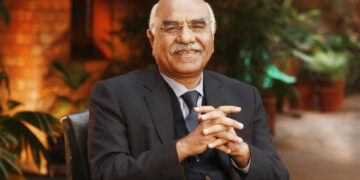 Hue mar ke hum jo rusva, hue kyon na gharq-e-dariya /
Na kabhi janaaza uthta, na kahin mazaar hota(Disgraced as I have been after my death, why didn’t I drown in a river /
There would not have been a funeral or a tomb anywhere)For somebody who said this, Mirza Ghalib’s bust was ironically installed at his last home in Ballimaran recently, nearly 142 years after his death. It was yet another tribute from an ardent admirer who has done more than perhaps anybody else to make the greatest of Urdu poets accessible to the current generations. Lyricist-film maker Gulzar, who has to his credit a masterpiece of a television series on Ghalib, commissioned the bust and gifted it to the Delhi government so that it could be installed at the haveli, in Gali Qasim Jaan where the poet-philosopher spent his last few years, a part of which has been converted into a museum.
Hue mar ke hum jo rusva, hue kyon na gharq-e-dariya /
Na kabhi janaaza uthta, na kahin mazaar hota(Disgraced as I have been after my death, why didn’t I drown in a river /
There would not have been a funeral or a tomb anywhere)For somebody who said this, Mirza Ghalib’s bust was ironically installed at his last home in Ballimaran recently, nearly 142 years after his death. It was yet another tribute from an ardent admirer who has done more than perhaps anybody else to make the greatest of Urdu poets accessible to the current generations. Lyricist-film maker Gulzar, who has to his credit a masterpiece of a television series on Ghalib, commissioned the bust and gifted it to the Delhi government so that it could be installed at the haveli, in Gali Qasim Jaan where the poet-philosopher spent his last few years, a part of which has been converted into a museum.
Gulzar is by no means the only lyricist or film-maker to have been inspired by Ghalib. Sohrab Modi made an award-winning film in 1954 with memorable music by Ghulam Mohammed. That, though, was at a time just after independence and Urdu had not yet fallen prey to the machinations of communal politics that led to the near-demise of the language. By the time Gulzar came up with his series, in the late 1980s, an entire generation had grown up which spoke Urdu-ised Hindi but could not read or write in the language chiselled by Ghalib and his contemporaries. In the intervening period, Ghalib had steadily risen in stature and comparative literature experts worldwide were comparing him favourably with the likes of even Shakespeare, Dante and Goethe. There was an urgent need, then, to revive interest in Ghalib’s works back home. The Gulzar-Naseeruddin Shah-Jagjit Singh combination worked like magic and many people flocked to the verses they would have never otherwise cared for.
Gulzar’s recent gesture is, therefore, more than welcome. It also highlights the failure of institutions such as the Urdu Academy and the Ghalib Academy in reaching out to the uninitiated. Ghalib, though, fortunately has his Gulzar. Mir, Momin, Zauq, Zafar, Chakbast and several other great masters are hardly read beyond the diminishing tribe of Urdu readers. While a part of Ghalib’s last home has been converted into a museum of sorts, the places associated with the other masters have either been neglected or even desecrated.The sheer indifference is not restricted to Urdu masters or poets alone. Even as we continue to ape the West in increasing walks of life, we have not yet imbibed its spirit of documentation, preservation and celebration of geniuses in literature and other fields. Had somebody in the West written ‘Hints for Self Culture’ instead of Lala Har Dayal, for example, the author would have continued to draw busloads of tourists to his birthplace and memorial just for this one work. Until we reach that level of consciousness, we need a Gulzar for every Ghalib – Khaleejnews











